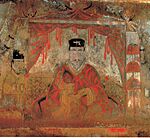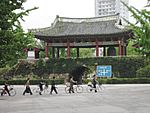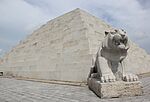List of World Heritage Sites in North Korea facts for kids
The United Nations Educational, Scientific and Cultural Organization (UNESCO) looks after World Heritage Sites. These are places that are very important for our culture or natural heritage. UNESCO set up the idea of World Heritage Sites in 1972.
Cultural heritage includes old buildings, sculptures, and archaeological sites. Natural heritage means special places like mountains, forests, or areas where rare animals and plants live. These sites are important for science, conservation, or their natural beauty.
North Korea, also known as the Democratic People's Republic of Korea, agreed to protect these sites on July 21, 1998. This meant its own special places could be added to the list. As of 2022, North Korea has two cultural sites on the list. These are the Complex of Koguryo Tombs, added in 2004, and Historic Monuments and Sites in Kaesong, added in 2013.
North Korea also has five sites on a "tentative list." This means they plan to suggest these places as World Heritage Sites in the future. In 2023, they started preparing Mt. Kumgang and its surrounding relics for a possible nomination.
World Heritage Sites in North Korea
UNESCO lists sites based on ten different rules or "criteria." Each site must meet at least one of these rules. Rules one to six are for cultural sites, and rules seven to ten are for natural sites.
| Site | Image | Location | UNESCO data | Year listed | Description |
|---|---|---|---|---|---|
| Complex of Koguryo Tombs |  |
Pyongyang and Nampo | 1091; Cultural: (i)(ii)(iii)(iv) |
2004 | This site has 30 ancient tombs. They date back to between the 3rd century BC and the 7th century AD. This was during the last years of the Goguryeo kingdom. People believe these tombs were for kings and important families. The site covers a large area of land. Each tomb has beautiful paintings inside. These paintings show us what life was like in that ancient time. UNESCO helps protect these tombs from damage from visitors and time. |
| Historic Monuments and Sites in Kaesong |  |
Kaesong | 1278rev; Cultural: (ii)(iii) |
2013 | Kaesong is in the southern part of North Korea. It used to be the capital city. It has 12 important monuments and sites. These places were built between the 10th and 14th centuries, during the Goryeo dynasty. They include old palaces, schools, graveyards, and city walls. There is also an old observatory and two schools. Their design shows how ideas changed from Buddhism to neo-Confucianism. It also shows how different cultures blended together. |
Tentative List of Sites
Besides the sites already on the World Heritage List, countries can make a "tentative list." This list includes places they think might be special enough to become World Heritage Sites in the future. A site must be on this tentative list before it can be officially nominated.
| Site | Image | Location (province) | UNESCO data | Year listed | Description |
|---|---|---|---|---|---|
| Caves in Kujang Area |  |
Kujang County, North Pyongan | 1426; Cultural: (vii)(viii)(ix) |
2000 | This site has three amazing underground caves. They are karstic caves, meaning they were formed by water dissolving limestones. This happened during the Quaternary period. The different shapes inside depend on the stalagmites and stalactites. Ryongmun Cave is special because it has 20 branches. Paekryong Cave has rock artworks. Songam Cave is known for its flower-shaped stone formations. |
| Historical Relics in Pyongyang |  |
Pyongyang | 1424; Cultural: (i)(ii)(iii)(iv)(vi) |
2000 | The city of Pyongyang has a very long history. It dates back to the Stone Age and Bronze Age. It was also important during the Goguryeo, Goryeo, and Yi dynasties. This site includes the Tomb of King Tangun. There are also old castles like Hwangdae and Chongamdong Earthen. You can find ancient villages and several dolmens here. Other important places are Anhak Palace, the Taesong Fortresses, and the Sungryong and Sungin Hall. There is also a pagoda at the Yongmyong Temple and other old buildings. |
| Mt. Chilbo |  |
North Hamgyong | 1427; Natural: (vii)(viii)(ix) |
2000 | Mt. Chilbo was formed by igneous rocks from the Paektu Mountain. This is why it has so many different kinds of rocks. It is also home to about 750 types of plants. You can find 20 kinds of mammals, 40 kinds of birds, and 10 kinds of reptiles here. The North Korean government already protects 11 natural monuments on this mountain. The mountain is divided into three parts: Inner, Outer, and Sea Chilbo. Each part has unique rock formations. |
| Mt. Kumgang and the Relics in and around the Mountain |  |
Hyangsan County, North Pyongan | 1425; Mixed | 2000 | Mt. Kumgang is also divided into Inner, Outer, and Sea areas. It has about 1,200 waterfalls and ponds. Many different animals live here. It also has plants that grow only in North Korea and in temperate and subarctic regions. Many of its cultural sites are Buddhist. These include the Pyohunsa temple and Podok Hermitage. There are also statues like Myogilsang and Sambulam. In May 2018, plans began to prepare this site to become a World Heritage Site. |
| Mt. Myohyang and the Relics in and around the Mountain |  |
North Pyongan | 1422; Mixed | 2000 | This site includes mountain ranges with peaks as high as 1,900 meters (6,200 feet). The sweet smell of its plants' wood gives Myohyang its nickname: "the mountain of curiosity, beauty and sweet smell." It has 20 Buddhist temples, like Pohyonsa. There are also preserved archives of 80,000 wooden blocks of the complete collection of Buddhist Sutras, from the 13th century. |
Images for kids
See also
 In Spanish: Anexo:Patrimonio de la Humanidad en Corea del Norte para niños
In Spanish: Anexo:Patrimonio de la Humanidad en Corea del Norte para niños
- Culture of North Korea
- Environment of North Korea
- Religion in North Korea








